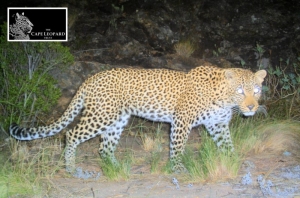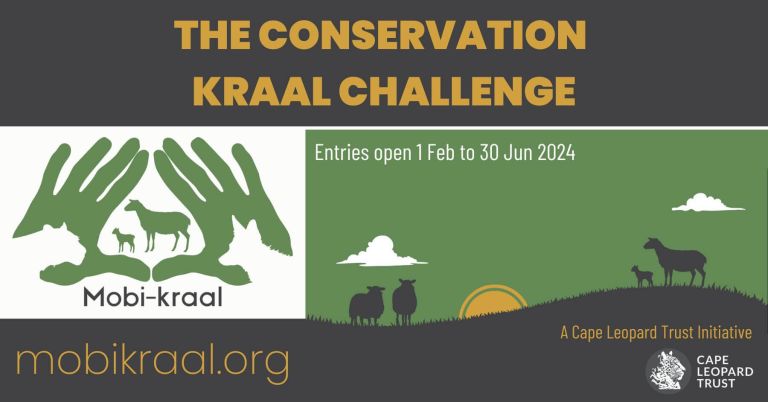Trapping wild animals is an invasive process unavoidably causing the captured animal stress and a risk of injury. Trapping therefore needs to be justified i.e. benefits of trapping must outweigh the risks. When trapping large predators such as leopards these risks are high and can only be carried out if the researcher’s institutions (e.g. University) and government conservation bodies (e.g. CapeNature) ethics committees approve the study. During this ethics review process, approval of a study is usually only given to the most proven stress-free and “safe” methods.
Ongoing debate concerning how ethical or safe the different trapping methods are has resulted in differing legal requirements for trapping animals even within some countries. In carnivore research, trapping study animals for conservation is often hampered by low study animal densities; large home range sizes, rugged and inaccessible terrain resulting in low trapping success rates. In order for succesful research to take place researchers have over decades developed a range of approaches most suitable for trapping species in their region.
Based on this, we give a short overview of three trapping methods considered by the Cape Leopard Trust as safe and humane (and which are internationally used by highly reputable carnivore research institutions and organisations).
Cage traps
Cage or Box traps were used extensively by the Cape Leopard Trust from 2005 - 2010 based on recommendations by CapeNature, and past research on leopards in the region. It is generally considered a "non-lethal" trap, and has advantages such as easy release of non-target species/or target individuals. There is however, a misconception that animals caught in cage traps do not sustain injuries. Depending on the scenarios, animals can seriously injure themselves or die in a cage trap. Some issues influencing this include trap design, construction material, how the trap is set, response time to engage with trapped animal, trap location (e.g. exposure to the sun), and the manner in which the trap is approached by researcher.
Leopards and caracals may thrash about in cages, causing deep tissue lacerations and abrasions; they bite at the cage walls risking broken canines; and dig to get out, causing ripped claws. All of these may affect hunting success and could prove fatal. Cage traps can also be non-selective if not set properly, resulting in a lot of “bycatch” including small antelope, porcupines, honey badgers and baboons. Being confined to a cage for long periods can cause severe stress or even death to any of these animals.
When set properly (with modifications to make the cage more target specific), monitored frequently (using radio transmitters to signal when a trap has been triggered), and ensuring close supervision, purpose-built cage traps still have a place as a trapping method, especially when the situation, terrain or habitat precludes the use of any other method.
Foot loop traps or Foot snares
Firstly, the foot snares we refer to should not to be confused with conventional crude wire snares set illegally to catch bushmeat. A foot loop trap is a highly modified, highly specialised type of snare which is globally regarded as the safest, most humane, and most effective capture technique for large felids (Gannon et al. 2007). Foot loop traps have been used for several decades around the world to safely capture and handle large carnivores for conservation purposes. For example, the very first snow leopards captured for research, and most since then, were caught using foot loop traps. In Africa, the past decade has seen a significant move away from using cage traps by large carnivore researchers to the use of foot loop traps.
This trapping method is promoted by the wildlife capture guidelines of the American Society of Mammalogists, an organisation regarded as a world-leader in promoting ethical research standards. One of the world's largest big cat conservation projects, Panthera, also uses this as their primary capture technique. All over the world, snow leopards, jaguars, cougars, tigers, lions, cheetahs, bears and wolves are all routinely and safely caught by researchers using this method.
The way we use foot loop traps minimises the risk of serious injuries typically associated with cages due to a number of measures put in place to minimise risk of injury and stress to the animal. Foot loop-related injuries are usually only slight soft tissue swelling to the capture paw (which normally subsides while the cat is being measured & weighed under sedation). Foot loop traps can also be highly selective. In the Cape Leopard Trust research areas, we have found this method to be 100% target specific over the past 4 years, with no non-target species captured. This is an exceptional record, and should realistically be over 80% to be considered very good.
It is important to note, all Cape Leopard Trust researchers undergo intensive training by a highly skilled professional research trapper for at least 1 month before they are allowed to employ this capture method on any research project. This training has come as considerable expense to the Trust, but is essential to ensure animal safety. Some sites are not suitable for the use of foot loops, and in such cases conventional cage traps are used.
Soft-catch traps
Certain animals, such as wild canids, are almost impossible to capture in a cage trap. In such cases, leg-hold traps are commonly used. An important distinction should be made between the traditional gin trap and modern “soft-catch” leg hold traps. These differ in that gin traps (such as the South African “Schneekluth” traps) are cruel and inhumane and designed to maim and kill; they have sharp (sometimes serrated) metal jaws causing severe soft-tissue, ligament and bone damage to any captured animal. Soft traps (e.g. Victor O’Neida “soft” traps), on the other hand, have offset jaws, thick rubberised pads, weaker springs, double swivels and springs on the chain to avoid ligament or muscle damage. Unlike a gin trap, a human can easily trigger a soft trap with his fingers and experience no damage whatsoever. Thus, although soft traps are also not necessarily entirely target-specific, non-target species caught in soft traps can generally be released unharmed.
Soft-catch leg-hold traps are used safely by researchers around the world – but once again the safety lies in the way this tool is used. Current scientific literature shows that appropriate soft traps, if correctly set and monitored cause comparatively little or no damage to trapped animals provided that they are regularly checked. Once again regular trap checks are vital. As with any other trapping method, risk of injury increases with time spent in the trap, and therefore response time needs to be minimised in order to minimise risk of injury. Again, all Cape Leopard Trust researchers undergo intensive training by a highly skilled professional trapper before they are allowed to employ this capture method on any research project.
We have provided some references from the scientific literature employing the methods described above. These are articles or publications peer-reviewed by experts in their fields and ratified by associated ethics committees from all over the world:
- Balme G., Hunter L. & Slotow R. 2007. Feeding habitat selection by hunting leopards Pantera pardus in a woodland savanna: prey catchability versus abundance. Animal Behaviour, 74, 589-598.
- Boitani L, Powell RA. 2012. Carnivore ecology and conservation: A handbook of techniques. Oxford University Press, Oxford.
- Earle R.D., Lunning D.M., Tuovila V.R., Shivik J.A. 2003. Evaluating injury mitigation and performance of #3 Victor Soft Catch® traps to restrain bobcats. Wildlife Society Bulletin, 31, 617-629.
- Englund J. 1982. A comparison of injuries to leg-hold trapped and foot-snared red foxes. Journal of Wildlife Management 46: 1113-1117.
- Frank, L., Simpson, D. & Woodroffe, R. 2003. Foot snares: an effective method for capturing African lions. Wildlife Society Bulletin 31: 309-314.
- Gannon, W.L., Sikes, R.S. and the Animal Care and Use Committee of the American Society of Mammalogists. 2007. Guidelines of the American society of mammalogists for the use of wild mammals in research. Journal of Mammalogy 88: 809-823.
- Goodrich JM, Kerley LL, Schleyer BO, Miquelle DG, Quigley KS, Smirnov EN, Nikolaev IG, Quigley HB, Hornocker MG. 2001. Capture and chemical anesthesia of Amur tigers. Wildlife Society Bulletin 29: 533–542.
- Jackson, R.M. (1996). Home range, movements and habitat use of snow leopard (Uncia uncia) in Nepal. PhD. thesis, University of London, London, U.K.
- Kolbe JA, Squires JR, Parker TW. 2003. An effective box trap for capturing lynx. Wildlife Society Bulletin 31: 980-985.
- Logan, K.A., Sweanor, L.L, Smith, J.F. & Hornocker, M.G. 1999. Capturing pumas with foot-hold snares. Wildlife Society Bulletin 27: 201-208.
- Mann, G. (2014). Aspects Of The Ecology Of Leopards (panthera Pardus) In The Little Karoo, South Africa - A Thesis Submitted In Fulfilment Of The Requirements Of Doctor Of Philosophy Of Rhodes University Department Of Zoology And Entomology
- Martins, Q. & Harris, S. (2013). Movement, activity and hunting behaviour of leopards in the Cederberg mountains, South Africa. African Journal of Ecology, pp. 1- 9.
- Martins, Q., Horsnell, W.G.C., Titus, W., Rautenbach, T. & Harris, S. (2011). Diet determination of the Cape Mountain leopards using global positioning system location clusters and scat analysis.Journal of Zoology 283, 81-87.
- Martins, Q. (2010). The ecology of the leopard Panthera pardus in the Cederberg Mountains. PhD Thesis, University of Bristol.
- McCarthy, T.M. (2000). Ecology and conservation of snow leopards, Gobi brown bears, and wild bactrian camels in Mongolia. PhD thesis, University of Massachusetts, Amherst, U.S.A.
- McCarthy, T.M., Fuller, T.K. & Munkhtsog, B. (2005). Movements and activities of snow leopards in southwestern Mongolia. Biological Conservation, 124, 527-537.
- Norton, P.M. & Lawson, A.B. (1985). Radio tracking of leopards and caracals in the Stellenbosch area, Cape Province. South African Journal of Wildlife Research, 15, 17-24.
- Novak M. 1981. The foot-snare and the leg-hold traps: a comparison. Proceedings of the Worldwide Furbearer Conference 3: 1671-1685.
- Olsen G.H., Linscombe R.G., Wright V.L. & Holmes R.A. (1988) Reducing injuries to terrestrial furbearers by using padded foothold traps. Wildlife Society Bulletin, 16, 303-307.
- Onderka DK, Skinner DL, Todd AW. 1990. Injuries to coyotes and other species caused by four models of footholding devices. Wildlife Society Bulletin 18: 175-182.
- Phillips RL, Gruver KS. 1996. Performance of the Paws-I-Trip™ pan tension device on 3 types of traps. Wildlife Society Bulletin 24: 119-122.
- Pitman, R.T., Swanepoel, L.H. & Ramsay, P.M. 2012. Predictive modelling of leopard predation using contextual Global Positioning System cluster analysis. Journal of Zoology 288: 222–230.
- Preuss TS, Gehring TM. 2007. Landscape analysis of bobcat habitat in the Northern Lower Peninsula of Michigan. Journal of Wildlife Management 71: 2699-2706.
- Swanepoel, L. (2008). Ecology of leopards (Panthera pardus) on selected game ranches in the Waterberg, Limpopo. MSc thesis, University of Pretoria, Pretoria, S.A.
- Thornton DH, Sunquist ME, Main MB. 2004. Ecological separation within newly sympatric populations of coyotes and bobcats in south-central Florida. Journal of Mammalogy, 85, 973-982.
- Turkowski FJ, Armistead AR, Linhart SB. 1984. Selectivity and effectiveness of pan tension devices for coyote foothold traps. Journal of Wildlife Management 48: 700-708.



















